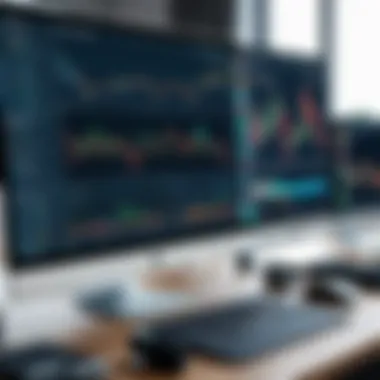Exploring the Depths of MT Trading Platforms


Intro
The landscape of trading technologies continues to evolve, making it imperative to understand the tools available in this space. MT trading platforms have emerged as key players in the realm of financial trading. Their specific architecture and functionalities influence how traders interact with financial markets. This section will serve as a foundation for a thorough examination of these platforms. Through this, readers can better appreciate their capabilities and overall relevance to trading strategies.
Software Overview
Brief Description of Software
MT trading platforms, primarily MetaTrader 4 and MetaTrader 5, are well-regarded in trading circles. These platforms are designed for online trading in forex, contracts for difference (CFDs), and futures. They offer a user-friendly interface alongside powerful features catered towards both novice and advanced traders. The inherent flexibility of the software supports a wide array of trading strategies.
Key Features and Functionalities
The platforms boast several features beneficial to traders, including:
- Real-time Market Data: Access to live market prices and data feeds allows traders to make informed decisions quickly.
- Charting Tools: Advanced charting options help visualize market movements through various indicators and drawing tools.
- Automated Trading: The ability to use Expert Advisors (EAs) enables traders to automate their strategies and reduce the reliance on manual processes.
- Multiple Order Types: Various order types enhance trading flexibility, accommodating different trading styles.
- Custom Indicators and Scripts: Traders can create or introduce custom indicators to tailor their trading experience based on specific needs.
Robust security measures further protect trading accounts, making these platforms appealing to a broad audience.
Detailed Comparison
Comparison with Competitors
While MT platforms hold a significant presence, their competitors such as cTrader and NinjaTrader offer alternative functionalities. For instance, cTrader is known for a more modern interface and advanced order types, while NinjaTrader positions itself more towards futures trading with complex analysis tools.
MT platforms are often favored for their widespread adoption and extensive community support, but they must continually adapt to evolving trader demands to retain their market leadership.
Pricing Structure
The pricing models for MT trading platforms typically differ based on the broker offering the software. Commonly, traders encounter:
- Commission-based Fees: Traders pay a percentage of each transaction.
- Spread Markup: Costs embedded in the spread, affecting cost clarity.
- Monthly Subscription Fees: Some brokers may offer premium versions of MT platforms with advanced features for a subscription fee.
It is crucial for traders to analyze the pricing structure offered by particular brokers to align their decision with their trading strategy and financial goals.
"Understanding the pricing model is as important as mastering the trading features; it minimizes unexpected costs."
Understanding MT Trading Platforms
In today’s trading environment, the significance of understanding MT trading platforms cannot be overstated. These platforms serve as the foundation for executing trades in various financial markets. They provide user-friendly interfaces, sophisticated trading tools, and the ability to analyze market conditions, which are essential for making informed decisions.
MT trading platforms facilitate a connection between traders and their brokers. Users can access real-time data, submit orders, and monitor their trading performance from a single interface. The benefits of using these platforms go beyond mere order execution. They open doors to various analytical tools and strategies, enabling users to customize their approach.
Additionally, the technological landscape is constantly evolving. New features and updates are regularly introduced to enhance user experience and improve execution speed. Thus, comprehending the latest advancements within MT trading platforms is crucial for traders who aim to stay competitive.
What are MT Trading Platforms?
MT trading platforms, specifically MetaTrader 4 and MetaTrader 5, are software applications used for trading in financial markets. They allow traders to manage accounts, analyze financial markets, and execute trades in real time. The platforms are particularly popular among forex traders but are also valid for other assets like stocks, commodities, and cryptocurrencies.
Key characteristics include:
- User-friendly interface: Easier navigation aids both novice and experienced traders.
- Support for automated trading: Through Expert Advisors (EAs), trading strategies can be automated.
- Comprehensive charting tools: Traders can analyze price movements and set alerts for specific conditions.
These elements illustrate how MT trading platforms simplify the complexity of trading. Their versatility makes them a top choice for many trading professionals.
The Evolution of Trading Platforms
The journey of trading platforms has been marked by significant advancements and innovations. Initially, trading was conducted through telephone calls with brokers. This method was slow and prone to human error. With the advent of the internet, electronic trading began to emerge.
MT trading platforms revolutionized this landscape. MetaTrader 4 was released in 2005, offering insights and functionalities that traditional methods could not match. In response to evolving trader needs, MetaTrader 5 followed in 2010, incorporating enhanced features like more technical indicators and an economic calendar.


The evolution from manual to automated trading systems highlights a critical shift in how trading is conducted today.
Several factors contributed to this evolution:
- Technological advancements: Increased internet speeds and computing power enabled more sophisticated tools.
- Market demands: Traders required faster executions and more robust analysis tools.
- Regulatory changes: New compliance requirements necessitated more transparent trading environments.
Overall, the evolution of trading platforms signifies a commitment to improving the trader's experience and outcomes.
Core Features of MT Trading Platforms
Understanding the Core Features of MT Trading Platforms is essential. These features often determine their usability, efficiency, and overall trading experience. Knowing what a platform can offer helps traders make informed decisions. Analyzing user interface elements, analytical tools, and order execution types will provide insights into how these aspects contribute to trading performance.
User Interface and Experience
The user interface is crucial in any trading platform. It dictates how easily users can navigate the platform. A clear and intuitive interface enhances user experience substantially. Users should have access to necessary tools without being overwhelmed. A well-designed interface often features:
- Customizable Layouts: This allows traders to arrange their workspace according to personal preference, which can increase productivity.
- Intuitive Navigation: Simple menus and toolbars make it easier to find options quickly, minimizing confusion.
- Responsive Design: Platforms must work efficiently on various devices including desktops and mobile devices.
The overall experience should not compromise functionality. A platform with a cluttered layout may frustrate users, leading potentially to errors in trading. Therefore, a user-centric design helps in streamlining processes, which is paramount for effective trading.
Charting and Analysis Tools
Charting and analysis tools are vital for traders aiming to strategize their trades. These functions allow for the interpretation of market data and trends. Critical components include:
- Technical Indicators: Tools like moving averages, RSI, and MACD assist in identifying potential entry and exit points.
- Customizable Charts: Traders should be able to adjust timeframes and chart types (like candlestick or line) to fit their trading style.
- News Feeds: Integration of relevant news can provide context to market movements, enhancing decision-making.
Access to sophisticated charting tools helps traders analyze market conditions effectively, which can lead to more informed trades. Without these tools, a trader may struggle to interpret market data.
Order Execution Types
Order execution is a critical aspect of any trading strategy. Different order types cater to various trading strategies. Thus, understanding these types can optimize trading activities. Common order execution types include:
- Market Orders: Executed immediately at the current market price. Useful for quick entries and exits.
- Limit Orders: Set a specific price for buying or selling, ensuring price control. This is beneficial during volatile market conditions.
- Stop-Loss Orders: Automatically sell an asset when it reaches a specified price, helping to minimize losses.
Different scenarios require different order types. Thus, having a platform that supports a variety of order executions allows traders to deploy more complex trading strategies effectively.
The features of MT trading platforms play a significant role in shaping trader success. The interface, analytical tools, and execution types enhance a trader's ability to navigate the market efficiently.
Advantages of Using MT Trading Platforms
The advantages of using MT trading platforms are significant and noteworthy. These platforms not only cater to the basic needs of traders but also enhance their overall trading experience. Understanding these advantages can help decision-makers identify how such platforms can fit into their trading operations.
Accessibility and Convenience
MT trading platforms stand out for their accessibility. Traders can access these platforms from various devices, including desktops, tablets, and mobile phones. This flexibility empowers users to engage in trading from anywhere at any time. For example, a trader might review charts or execute orders while traveling or at work.
Moreover, many MT platforms offer cloud-based options, allowing for seamless updates and access to personal profiles across multiple devices. This feature eliminates the need for constant software installations and ensures all trading activities remain in sync.
Integration with Trading Tools
Another highlight of MT trading platforms is their ability to integrate with a multitude of trading tools. These platforms usually support a wide range of third-party applications. This includes technical analysis tools, signal services, and news feeds. By integrating these tools, traders can customize their trading environment according to their personal preferences and strategies.
Furthermore, APIs allow for deeper integration, enabling algorithms and automated trading systems to function efficiently. Trader can connect their own strategies and systems directly to the platform, making it easier to deploy complex trading strategies without switching platforms or interfaces.
Advanced Analytical Capabilities
MT trading platforms are equipped with advanced analytical capabilities that are crucial for making informed trading decisions. Built-in features such as complex charting tools, market analysis indicators, and backtesting options provide traders with the necessary resources to scrutinize market movements carefully.
For instance, traders can leverage tools like Fibonacci retracement levels, Bollinger Bands, and moving averages to predict future price action. These analytical capabilities empower traders with insights that inform their strategies and enhance their decision-making process.


"A trader needs the right tools to analyze the market, and MT platforms provide those tools effectively."
Common Challenges with MT Trading Platforms
Navigating the world of MT trading platforms comes with its own set of obstacles. These challenges can hinder effective trading and affect user performance. Acknowledging and addressing these difficulties is essential for anyone looking to utilize MT platforms effectively in their trading strategies. Below, we explore two primary challenges that users often face: the learning curve and risk management limitations.
Learning Curve for New Users
One of the most notable challenges for beginners using MT trading platforms is the steep learning curve. Users who are familiar with general trading concepts may find the specific tools and features of platforms like MetaTrader 4 and MetaTrader 5 somewhat daunting.
New users may struggle with the following aspects:
- Complex User Interface: Although designed for efficiency, the interface may seem overwhelming at first. Understanding where tools and features are located takes time.
- Advanced Features: Many MT platforms offer advanced functions such as algorithmic trading, custom indicators, and more. Grasping how to use these features requires dedicated practice.
- Support Resources: While documentation exists, it might not always provide clear, useful guidance. New users often rely on online forums or community discussions on platforms like Reddit for insights and troubleshooting tips.
It is crucial for users to invest time in learning the platform. Many tutorials and videos are available to assist newcomers. Engaging with experts can also alleviate frustrations during the learning process.
Risk Management Limitations
Risk management is a fundamental aspect of successful trading. However, MT trading platforms can present certain limitations in this area. Traders must be aware of potential pitfalls that could lead to significant financial loss.
Key considerations include:
- Default Risk Settings: Many MT platforms have preset configurations for risk management, which may not suit everyone’s trading style. Understanding how to adjust these settings is essential for effective risk control.
- Lack of Integrated Risk Tools: Compared to proprietary platforms, third-party MT platforms sometimes lack advanced risk management options. Identifying these gaps can be challenging for users who expect comprehensive tools.
- Market Volatility: Rapid market changes can catch traders off guard. Users need to remain vigilant about broader market conditions and should ensure they have strategies in place for different market scenarios.
In summary, tackling the learning curve and addressing risk management limitations is crucial for optimizing MT trading platforms. Awareness of these challenges empowers users to make informed decisions to safeguard their investments.
Comparison of Popular MT Trading Platforms
In the rapidly evolving landscape of trading platforms, understanding the distinctions among various offerings is crucial for traders. The comparison of popular MT trading platforms serves as a roadmap for decision-makers seeking to leverage technology for optimal trading performance. This section aims to highlight the essential differences and advantages of each platform, addressing unique features and functionalities that can influence a trader’s experience and success.
MetaTrader vs MetaTrader
MetaTrader 4 (MT4) and MetaTrader 5 (MT5) are among the most widely used trading platforms globally. Each platform possesses unique characteristics that cater to diverse trading strategies. MT4 is primarily recognized for its robust trading capabilities, particularly in Forex trading. It provides a user-friendly interface and a vast repository of plugins and indicators, making it a favorite for many traders. Its simplicity is a strong selling point but comes with limitations, particularly in market analysis and asset classes.
On the other hand, MT5 expands upon the foundational features of MT4, introducing more comprehensive tools and functionalities. MT5 supports additional asset classes, including stocks and commodities, which offers a broader spectrum for traders. The built-in economic calendar, advanced tools for analysis, and improved order execution options enhance the trading experience on MT5. While MT4 remains immensely popular, MT5 is carving out its own niche, appealing to traders who require a more sophisticated toolbox.
"Choosing between MT4 and MT5 essentially depends on one's trading strategy and asset preference."
Key Differences:
- User Interface: MT4 offers a more straightforward interface, while MT5 has a more modern layout with added features.
- Asset Classes: MT4 is predominantly for Forex trading, whereas MT5 encompasses a wider array of assets, including stocks and futures.
- Technical Indicators: MT5 includes 38 technical indicators, compared to MT4's 30, enhancing analytical capability.
- Order Types: MT5 supports more advanced order types and offers improved execution speeds.
These differences become vital in aligning the platform with a trader's strategy and goals.
Third-Party MT Platforms
In addition to MetaTrader’s official platforms, numerous third-party MT platforms have emerged, providing traders with alternative solutions tailored to specific needs. These platforms often incorporate innovative features or specialized tools that target niche markets or enhance user experience.
Some notable third-party platforms include cTrader and TradingView. cTrader is known for its intuitive design and advanced charting capabilities. It provides functionalities like Level II pricing and customizable indicators, appealing to both novice and advanced traders.
TradingView, meanwhile, stands out for its social trading features. Users can share ideas and strategies in an interactive environment. It integrates with various brokerage accounts, enabling users to trade directly from the platform.
Benefits of Third-Party Platforms:
- Customization: Many third-party platforms offer customizable interfaces to suit traders' preferences.
- Innovation: They often introduce cutting-edge tools that may not be available on traditional platforms.
- Community Features: Platforms like TradingView encourage collaboration and sharing among traders, fostering a community spirit.
While these alternatives present many advantages, traders should consider the reliability and compatibility of these platforms with their main trading strategies before adoption. Selecting the right platform ultimately shapes the efficiency and effectiveness of the trading process.
Best Practices for Using MT Trading Platforms


Understanding best practices when using MT trading platforms is crucial for achieving optimal trading performance. In a landscape that continually evolves due to technology advancements, adhering to strategic guidelines can markedly enhance a trader's efficiency and effectiveness. These practices provide a foundation on which both beginner and seasoned traders can build their trading activities to mitigate risks and optimize outcomes.
Building a Trading Strategy
A well-defined trading strategy is the bedrock of successful trading. Traders should begin by assessing their risk appetite and financial objectives. This assessment will help dictate the style of trading, ranging from day trading to long-term investments.
Key components of a trading strategy include:
- Market Analysis: Utilize fundamental and technical analysis to identify potential trading opportunities. Understanding market trends helps forecast future movements.
- Entry and Exit Points: Clearly define the criteria for entering and exiting trades. This includes setting stop loss and take profit levels to protect investments.
- Consistent Review: Regularly review and adjust your trading strategy based on performance data and changing market conditions. This iterative process can identify weaknesses and ensure continuous improvement.
Incorporating these elements can significantly improve decision-making and minimize emotional trading, which often leads to losses.
Utilizing Automation Tools
Automation tools are indispensable for modern traders. These tools allow for stronger efficiency and can minimize the fear of missing out or reacting impulsively in a volatile market. By employing automation, traders can execute complex tasks without constant manual intervention.
Essential automation techniques include:
- Expert Advisors: These algorithms allow traders to automate their trading strategy using scripts in MetaTrader. Traders can backtest strategies and optimize parameters to enhance profitability.
- Trade Alerts: Setting up alerts can notify traders of significant price movements or trends, enabling timely responses without constant monitoring.
- Portfolio Management Tools: Automation reduces the stress of managing multiple assets. Proper tools help maintain balance while maximizing returns on investments.
By effectively utilizing automation tools, traders can focus on strategy refinement, rather than spending excessive time on routine tasks.
"Automation in trading can not only simplify processes but also ensure systematic execution of strategies, which is crucial in fast-paced trading environments."
In summary, adopting best practices in using MT trading platforms provides a substantial advantage. Traders can enhance their strategies and outcomes, leading to better overall performance. As the trading industry continues to evolve, those who refine their practices accordingly will likely reap the most significant rewards.
Future Trends in MT Trading Platforms
In the fast-evolving domain of trading technology, understanding future trends in MT trading platforms is crucial for professionals looking to maintain a competitive edge. These trends not only influence trading strategies but also reshape the functionality and user experience of these platforms. As traders increasingly rely on technology to make decisions, being aware of upcoming changes and advancements is vital.
It is essential to recognize how various technologies are set to impact the landscape of trading. For decision-makers and IT professionals, grasping these future trends allows for more informed choices regarding platform selection and integration. Additionally, entrepreneurs can leverage these insights to innovate and create products that resonate with the needs of modern traders.
Artificial Intelligence in Trading
Artificial Intelligence (AI) is becoming a pivotal force in trading platform functionalities. Its application serves multiple purposes, enhancing efficiency and improving decision-making. AI integrates algorithms that analyze vast amounts of data, including historical price movements and market sentiment, to predict market trends. Utilizing machine learning helps develop models that adapt over time, refining their predictions.
- Sentiment Analysis: AI systems can gauge market sentiment from various sources, such as news articles, forums, and social media. This information can be significant in understanding market direction and trader behavior.
- Automated Trading: AI facilitates automated trading strategies that can execute trades based on predefined criteria. This decreases the chances of emotional trading, enhancing discipline and consistency in executing strategies.
Despite these benefits, reliance on AI also poses challenges. It is crucial to ensure that traders understand the models being applied and the data driving the system's decisions. Transparency is key in building trust and ensuring effective utilization of AI tools.
Blockchain Technology Impacts
Blockchain technology is another trend poised to influence MT trading platforms significantly. As a decentralized ledger system, it brings a new level of security and transparency in transactions. The very nature of blockchain enhances the credibility of the trades executed through such platforms.
- Increased Security: With blockchain, the risk of fraud is reduced significantly as transactions are immutable. This feature can give traders greater confidence.
- Smart Contracts: These self-executing contracts facilitate the automation of trade agreements, minimizing the need for intermediaries and thereby reducing costs and time delays.
- Tokenization of Assets: Blockchain allows for the tokenization of various assets, making it easier to trade assets like real estate or art. This opens the market to a wider array of investors.
Blockchain technology also presents its challenges. Scalability issues and regulatory uncertainty can affect its widespread adoption. However, the potential benefits suggest that these issues may be addressed as the technology matures.
In summary, AI and blockchain are not just trends; they are transformative technologies poised to redefine the trading landscape. Understanding these shifts is vital for anyone involved in trading, be it a trader, a developer, or a business leader.
Ending and Recommendations
In the rapidly changing landscape of financial trading, an informed decision regarding the choice of MT trading platform can significantly influence one’s success. This section aims to summarize the essential points discussed in this article while providing actionable recommendations.
Assessing Your Trading Needs
Understanding one's unique trading requirements is a fundamental step in selecting an appropriate MT trading platform. Factors to consider include:
- Trading Style: Are you a day trader, swing trader, or long-term investor? Different platforms cater to varying trading strategies.
- Asset classes: Consider the types of instruments you will trade, such as forex, stocks, commodities, or cryptocurrencies. Certain platforms offer better instruments than others.
- Experience Level: New traders may prefer platforms with robust educational support, while seasoned traders might seek advanced analytic capabilities.
- Budget: Different platforms have various fee structures. Ensure to account for spreads, commissions, and possible withdrawal fees when evaluating your options.
Accessing a demo account offered by some platforms can also assist in understanding the functionalities available. This reduces the risk associated with trial and error in a live setting, allowing traders to familiarize themselves with the interface.
Long-term Benefits of Choosing the Right Platform
Selecting the right MT trading platform goes beyond immediate trading needs and can yield long-lasting benefits, including:
- Enhanced Performance: The right platform can optimize execution speed and reliability, critical for active traders who rely on real-time data.
- Customization: Many MT platforms allow customization to suit personal preferences, which can enhance the trading experience and boost confidence.
- Continued Support: A reputable platform typically offers continuous updates and customer support to address any issues that may arise.
- Scalability: As your trading career progresses, a suitable platform will accommodate growth. This includes expanding into more complex instruments like options and futures or increasing trade volumes.







